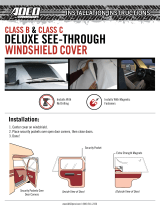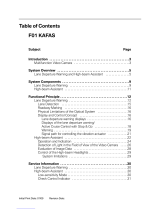Page is loading ...

Technical�training.
Product�information.
BMW�Service
F48�General�Vehicle�Electronics

General�information
Symbols�used
The�following�symbol�is�used�in�this�document�to�facilitate�better�comprehension�or�to�draw�attention
to�very�important�information:
Contains�important�safety�information�and�information�that�needs�to�be�observed�strictly�in�order�to
guarantee�the�smooth�operation�of�the�system.
Information�status�and�national-market�versions
BMW�Group�vehicles�meet�the�requirements�of�the�highest�safety�and�quality�standards.�Changes
in�requirements�for�environmental�protection,�customer�benefits�and�design�render�necessary
continuous�development�of�systems�and�components.�Consequently,�there�may�be�discrepancies
between�the�contents�of�this�document�and�the�vehicles�available�in�the�training�course.
This�document�basically�relates�to�the�European�version�of�left-hand�drive�vehicles.�Some�operating
elements�or�components�are�arranged�differently�in�right-hand�drive�vehicles�than�shown�in�the
graphics�in�this�document.�Further�differences�may�arise�as�a�result�of�the�equipment�specification�in
specific�markets�or�countries.
Additional�sources�of�information
Further�information�on�the�individual�topics�can�be�found�in�the�following:
• Owner's�Handbook
• Integrated�Service�Technical�Application.
Contact:�conceptinfo@bmw.de
©2015�BMW�AG,�Munich
Reprints�of�this�publication�or�its�parts�require�the�written�approval�of�BMW�AG,�Munich
The�information�contained�in�this�document�forms�an�integral�part�of�the�technical�training�of�the
BMW�Group�and�is�intended�for�the�trainer�and�participants�in�the�seminar.�Refer�to�the�latest�relevant
information�systems�of�the�BMW�Group�for�any�changes/additions�to�the�technical�data.
Information�status:�June�2015
BV-72/Technical�Training

F48�General�Vehicle�Electronics
Contents
1. Vehicle�Electrical�System............................................................................................................................................................................................. 1
1.1. Data�bus�overview................................................................................................................................................................................................ 1
1.2. Main�bus�systems.................................................................................................................................................................................................3
1.2.1. K-CAN.................................................................................................................................................................................................... 3
1.2.2. PT-CAN................................................................................................................................................................................................ 8
1.2.3. FlexRay..................................................................................................................................................................................................9
1.2.4. D-CAN................................................................................................................................................................................................13
1.2.5. Ethernet...........................................................................................................................................................................................13
1.2.6. MOST..................................................................................................................................................................................................13
1.3. Sub-bus�systems...............................................................................................................................................................................................13
1.3.1. Local�interconnect�network�bus...............................................................................................................13
1.3.2. Local-CAN...................................................................................................................................................................................14
1.3.3. USB........................................................................................................................................................................................................ 14
1.3.4. APIX....................................................................................................................................................................................................... 14
1.4. Control�units..............................................................................................................................................................................................................15
1.4.1. Complete�overview........................................................................................................................................................15
1.4.2. Body�Domain�Controller....................................................................................................................................... 17
1.4.3. Frontal�Light�Electronics...................................................................................................................................... 17
1.4.4. TRSVC�control�unit.......................................................................................................................................................18
1.4.5. Park�Distance�Control/Parking�Maneuver�Assistant................................................. 19
1.4.6. Crash�Safety�Module................................................................................................................................................. 20
1.4.7. Dynamic�Stability�Control...................................................................................................................................20
1.4.8. Optional�equipment�system............................................................................................................................21
1.4.9. Camera-based�driver�support�systems.........................................................................................22
1.4.10. Automatic�operation�of�tailgate................................................................................................................. 23
1.4.11. Longitudinal�torque�distribution............................................................................................................... 23
2. Voltage�Supply............................................................................................................................................................................................................................. 24
2.1. Overview.......................................................................................................................................................................................................................... 24
2.2. Components.............................................................................................................................................................................................................. 26
2.2.1. Battery............................................................................................................................................................................................... 27
2.2.2. Intelligent�battery�sensor.....................................................................................................................................27
2.2.3. Power�distribution�boxes......................................................................................................................................28
3. Exterior�Lights...............................................................................................................................................................................................................................30
3.1. Headlights......................................................................................................................................................................................................................30
3.1.1. Halogen�headlight...........................................................................................................................................................30
3.1.2. LED�headlight�with�extended�scope..................................................................................................31
3.1.3. fog�lights........................................................................................................................................................................................ 34
3.2. Rear�lights..................................................................................................................................................................................................................... 35
3.2.1. In�vehicles�with�halogen�headlights....................................................................................................35

F48�General�Vehicle�Electronics
Contents
3.2.2. Vehicles�with�LED�headlights.......................................................................................................................36
4. Interior�Lighting..........................................................................................................................................................................................................................37
4.1. System�wiring�diagram.............................................................................................................................................................................38
5. Heating/Air�Conditioning�Systems..........................................................................................................................................................41
5.1. Components�and�systems..................................................................................................................................................................41
5.1.1. Integrated�automatic�heating�and�air�conditioning......................................................41
5.1.2. Heating�and�air-conditioning�unit...........................................................................................................46
5.1.3. Microfilter...................................................................................................................................................................................... 48
5.1.4. Air/Water�separation�(Venturi�adapter)........................................................................................... 49
5.1.5. ECO�PRO�mode�of�heating�and�air�conditioning�program...............................51
6. Locking�and�Security�Functions..................................................................................................................................................................52
6.1. Overview�of�functions.................................................................................................................................................................................54
6.1.1. Remote�control�receiver........................................................................................................................................55
6.2. Central�locking�system............................................................................................................................................................................. 55
6.2.1. Special�functions.............................................................................................................................................................. 56
6.2.2. System�wiring�diagram............................................................................................................................................57
6.3. Comfort�Access................................................................................................................................................................................................... 59
6.3.1. System�wiring�diagram............................................................................................................................................60
6.3.2. System�components...................................................................................................................................................62
6.4. Hands�free�tailgate�opening............................................................................................................................................................. 63
6.4.1. System�wiring�diagram............................................................................................................................................64
6.4.2. Functional�description�of�tailgate�opening.............................................................................. 65
7. Alarm�System..................................................................................................................................................................................................................................69
7.1. System�wiring�diagram.............................................................................................................................................................................69
8. Wash/Wipe�System...............................................................................................................................................................................................................71
8.1. Introduction................................................................................................................................................................................................................. 71
8.2. Operation........................................................................................................................................................................................................................ 71
8.3. System�wiring�diagram.............................................................................................................................................................................72
9. Steering�Wheel�Heating...............................................................................................................................................................................................74
9.1. System�wiring�diagram.............................................................................................................................................................................74

F48�General�Vehicle�Electronics
1.�Vehicle�Electrical�System
1
1.1.�Data�bus�overview
F48�data�bus�overview

F48�General�Vehicle�Electronics
1.�Vehicle�Electrical�System
2
Index Explanation
1 Start-up�node�control�units�for�starting�and
synchronizing�the�FlexRay�bus�system
2 Control�units�with�wake-up�authorisation
ACSM Advanced�Crash�Safety�Module
AMP Audio�amplifier
BDC Body�Domain�Controller
CID Central�information�display
CON Controller
DME Digital�Motor�Electronics
DSC Dynamic�Stability�Control
EGS Electronic�transmission�control
EPS Electronic�Power�Steering
FLEL Frontal�Light�Electronics�Left
FLER Frontal�Light�Electronics�Right
FZD Roof�function�center
HEADUNIT Headunit
HKL Automatic�operation�of�tailgate
HUD Head‐Up�Display
IHKA Integrated�heating�and�air�conditioning
KAFAS Camera-based�driver�support�systems
KOMBI Instrument�cluster
LMV Longitudinal�torque�distribution
PDC Park�Distance�Control
PMA Parking�Manoeuvring�Assistant
SAS Optional�equipment�system
SMFA Driver's�seat�module
TBX Touchbox
TCB Telematic�Communication�Box
TRSVC Control�unit�for�rear�view�camera�and�Side�View
ZGM Central�gateway�module

F48�General�Vehicle�Electronics
1.�Vehicle�Electrical�System
3
1.2.�Main�bus�systems
1.2.1.�K-CAN
In�the�F48�the�following�K-CANs�are�used:
• K-CAN2
• K-CAN3
• K-CAN4
All�K-CAN�data�buses�have�a�data�transfer�rate�of�500kBit/s.
The�K-CAN�with�100�kBit/s�is�no�longer�used�in�the�F48.

F48�General�Vehicle�Electronics
1.�Vehicle�Electrical�System
4
K-Can�termination
F48�K-Can�termination

F48�General�Vehicle�Electronics
1.�Vehicle�Electrical�System
5
Index Explanation
1 Body�Domain�Controller�(BDC)
2 Integrated�heating�and�air�conditioning
3 Headunit
4 Controller�(CON)
5 K-CAN�terminator
6 Touchbox�(TBX)
7 Audio�amplifier�(AMP)
8 Telematic�Communication�Box�(TCB)
The�CAN�buses�are�shown�in�the�overview�of�the�bus�systems.�The�actual�physical�layout�(topology)�is
shown�using�the�example�of�the�K-CAN2.
As�with�most�bus�systems,�terminating�resistors�are�also�used�for�protection�of�the�K-CAN�to�avoid
residual�voltages�on�the�data�lines.
The�terminating�resistors�for�the�termination�are�located�in�the:
• Body�Domain�Controller�and
• K-CAN�terminators.
All�other�control�units�are�connected�at�the�K-CAN�terminator�without�a�terminating�resistor.

F48�General�Vehicle�Electronics
1.�Vehicle�Electrical�System
6
CAN�terminator
CAN�terminator
Depending�on�the�equipment�package,�in�the�CAN�terminator�the�terminating�resistor�for�the
corresponding�CAN�bus�is�installed.�The�terminating�resistor�comprises�two�resistances�connected
in�series,�each�60�Ohm.�A�measuring�tap�against�ground�with�a�capacitor�for�the�reduction�of�high-
frequency�faults�is�also�installed.�Ferrite�beads�are�installed�for�all�bus�lines�in�the�CAN�terminator.
Ferrite�beads�suppress�high-frequency�faults�on�the�CAN�data�lines,�thus�making�possible�line�lengths
of�up�to�5m�in�the�wiring�harness.
Ferrite�core
A�ferrite�core�is�a�component�made�from�the�ferromagnetic�material�iron�oxide�hematite�(Fe203).�It�is
characterized�by�low�or�no�conductivity.�The�inductance�or�the�magnetic�field�is�increased�as�part�of�a
coil�(throttle�or�transformer).�If�a�ferrite�core�is�secured�around�a�conductor,�which�routes�signals�at�low
frequency�or�direct�current�voltage,�high-frequency�faults�are�attenuated�with�its�help.
Ferrite�core
Index Explanation
1 Ferrite�core�using�the�example�of�a�USB�line

F48�General�Vehicle�Electronics
1.�Vehicle�Electrical�System
7
Oscilloscope
If�there�are�no�terminating�resistors�in�a�CAN�bus�or�they�are�faulty,�this�may�lead�to�reflections�or
faults.�These�reflections�or�faults�are�shown�in�the�following�graphic:
Oscilloscope�holder�K-CAN
Index Explanation
1 Oscilloscope�holder�with�active�CAN�terminator
2 Oscilloscope�holder�with�disconnected�or�faulty�CAN�terminator

F48�General�Vehicle�Electronics
1.�Vehicle�Electrical�System
8
Installation�location
Depending�on�the�equipment�package,�a�maximum�of�four�CAN�terminators�are�installed�in�the�F48.
The�installation�locations�are�shown�in�the�following�graphic:
F48�installation�location�of�CAN�terminators
Index Explanation
1 CAN�terminator�integrated�in�the�Body�Domain�Controller
2 K-CAN3�terminator,�rear�right
3 K-CAN2�terminator,�rear�right
4 K-CAN4�terminator,�rear�left
1.2.2.�PT-CAN
In�the�F48�the�following�PT-CANs�are�used:
• PT-CAN
• PT-CAN2

F48�General�Vehicle�Electronics
1.�Vehicle�Electrical�System
9
1.2.3.�FlexRay
F48�system�wiring�diagram�for�FlexRay

F48�General�Vehicle�Electronics
1.�Vehicle�Electrical�System
10
Index Explanation
1 Digital�Motor�Electronics�(DME)
2 Electronic�Power�Steering�(electromechanical�power�steering)�(EPS)
3 Dynamic�Stability�Control�(DSC)
4 Body�Domain�Controller�(BDC)
5 Optional�equipment�system�(SAS)
6 Crash�Safety�Module�(ACSM)
FlexRay�data�bus�topology
The�FlexRay�is�shown�in�a�simplified�form�in�the�data�bus�overview.�The�actual�topology�(star-shaped
data�bus�topology)�is�shown�in�the�graphic�at�the�top.
The�star�coupler�with�four�drivers�is�located�in�the�Body�Domain�Controller�(BDC).�The�FlexRay�control
units�are�connected�to�these�bus�drivers�independent�of�their�termination�type.
Bus�termination
As�with�most�bus�systems,�resistors�are�also�used�for�termination�for�the�FlexRay�to�avoid�reflections
on�the�data�lines�at�both�ends�of�the�data�lines.�The�value�of�these�terminating�resistors�is�calculated
from�the�data�transfer�speed�and�the�cable�lengths.�The�terminating�resistors�are�located�in�the�control
units.�In�the�F48�the�terminating�resistors�have�a�value�of�90ohm�(total�resistance�45ohm).
Use�the�vehicle�wiring�diagram�for�measuring�the�(de-energized)�FlexRay�data�bus�for�the
determination�of�the�line�or�terminating�resistor.
Signal�properties
Electrical�faults,�which�arise�from�incorrect�cable�routing,�contact�resistances,�etc.�may�cause�faulty
data�transfer.

F48�General�Vehicle�Electronics
1.�Vehicle�Electrical�System
11
Oscilloscope�presentation�of�FlexRay
The�voltage�ranges�of�the�FlexRay�bus�system�are:
• System�ON�-�no�bus�communication�2.5V
• High�signal�-�3.1V�(voltage�signal�increases�to�600mV�and�upwards)
• Low�signal�-�1.9V�(voltage�signal�decreases�from�600mV�downwards)
The�voltage�values�are�measured�against�ground.

F48�General�Vehicle�Electronics
1.�Vehicle�Electrical�System
12
Deterministic�data�transfer
Deterministic�data�transfer
Index Explanation
1 Time-controlled�range�of�cyclical�data�transfer
2 Event-controlled�range�of�cyclical�data�transfer
3 Cycle�[5ms�overall�cycle�duration,�of�which�3ms�static�(=�time-controlled)
and�2ms�dynamic�(=�event-controlled)]
n Speed�of�rotation
<° Angle
t° Temperature
v Speed
xyz...�abc... Event-controlled�information
t Time

F48�General�Vehicle�Electronics
1.�Vehicle�Electrical�System
13
The�CAN�bus�system�is�an�event-controlled�bus�system.�Data�is�transmitted�when�an�event�occurs.
As�these�events�have�different�priorities�(e.g.�ambient�temperature�has�a�lower�priority�than�a�DSC
intervention,�for�example),�the�priorities�are�also�sent�in�the�bus�message.�The�message�with�the
higher�priority�is�sent�first.�As�the�control�unit�still�wants�to�send�the�message�which�has�the�lower
priority,�it�frequently�results�in�overloading�in�the�bus�systems.
The�FlexRay�works�with�so-called�"time�slots".�With�this�method�the�messages�are�sent�and�are�not
controlled�by�events,�but�each�control�unit�in�the�FlexRay�network�is�assigned�a�fixed�time�slot�in�which
it�sends�its�message�within�a�certain�period.�This�time�slot�is�synchronised�with�every�restart�of�the
data�bus.�The�control�units�which�synchronize�the�FlexRay�are�always�labelled�in�the�bus�diagram�with
a�"S"�(see�chapter�1.1).
The�FlexRay�can�also�be�synchronised�with�the�BMW�diagnosis�system�in�the�event�of�a�fault�and
corresponding�fault�code.
1.2.4.�D-CAN
The�D-CAN�for�the�vehicle�diagnosis�has�a�data�transfer�rate�of�500�kBit/s.
1.2.5.�Ethernet
The�Ethernet�access�is�used�for�programming�the�entire�vehicle.
In�a�F48�with�navigation�system�the�map�update�for�the�navigation�can�also�be�effected�using�the
Ethernet�interface.
1.2.6.�MOST
In�the�F48�the�Media�Oriented�System�Transport�(MOST)�bus�works�at�a�data�transfer�rate�of
22.5MBit/s.
1.3.�Sub-bus�systems
1.3.1.�Local�interconnect�network�bus
Different�data�rates�are�used�for�the�local�interconnect�network�bus�according�to�the�information
required.�The�data�transfer�rates�of�the�local�interconnect�network�bus�in�the�F48�range�from�19.2kBit/
s�to�20.0kBit/s.
Examples:
• 19.2�kBit/s�FLEL,�FLER
• 20.0�kBit/s�remote�control�receiver
The�Body�Domain�Controller�is�designed�for�the�different�data�rates�at�the�corresponding�inputs.

F48�General�Vehicle�Electronics
1.�Vehicle�Electrical�System
14
1.3.2.�Local-CAN
With�corresponding�optional�equipment,�the�Local�Controller�Area�Network�connects�the�optional
equipment�system�(SAS)�with�the�control�unit�for�the�camera-based�driver�support�systems�(KAFAS).
The�Local�Controller�Area�Network�has�a�data�transfer�rate�of�500kBit/s.
1.3.3.�USB
Depending�on�the�equipment,�the�following�USB�connections�are�possible:
• from�the�headunit�to�the�Telematic�Communication�Box�(TCB)
• from�the�headunit�to�the�telephone�base�plate
• from�the�headunit�to�the�USB�port
1.3.4.�APIX
The�central�information�display�(CID)�and�the�Head‐Up�Display�(HUD)�in�the�F48�are�not�connected�to
a�vehicle�data�bus.�Both�control�units�are�connected�directly�to�the�headunit�via�an�APIX�interface�or
the�instrument�cluster�(KOMBI).�APIX�(Automotive�Pixel�Link)�is�a�bit-serial�data�transfer�system.
APIX
Index Explanation
1 APIX�transmitter
2 Message�to�be�sent�(max.�1Gbit/s)
3 APIX�receiver
4 Confirmation�message�(62.5Mbit/s)

F48�General�Vehicle�Electronics
1.�Vehicle�Electrical�System
15
1.4.�Control�units
This�chapter�contains�information�on�control�units,
• which�are�used�for�the�first�time�in�the�F48
• which�have�been�adapted�for�the�F48
1.4.1.�Complete�overview
The�installation�locations�of�all�the�control�units�are�shown�in�the�following�graphic.
F48�Installation�location�of�the�control�units

F48�General�Vehicle�Electronics
1.�Vehicle�Electrical�System
16
Index Explanation
1 Frontal�Light�Electronics�Right�(FLER)
2 Dynamic�Stability�Control�(DSC)
3 Body�Domain�Controller�(BDC)
4 Camera-based�driver�support�systems�(KAFAS)
5 Headunit
6 Controller�(CON)
7 Roof�function�center�(FZD)
8 Optional�equipment�system�(SAS)
9 Park�Distance�Control�(PDC)/Parking�Manoeuvring�Assistant�(PMA)
10 Automatic�operation�of�tailgate�(HKL)
11 Rear�view�camera�(RFK)
12 Telematic�Communication�Box�(TCB)
13 Amplifier�(AMP)
14 Touchbox�(TBX)
15 Longitudinal�torque�distribution�(LMV)
16 Crash�Safety�Module�(ACSM)
17 Driver's�seat�module(SMFA)
18 Instrument�cluster�(KOMBI)
19 Integrated�heating�and�air�conditioning�(IHKA)
20 Electronic�Power�Steering�(EPS)
21 Digital�Engine�Electronics�(DME)
22 Electronic�transmission�control�(EGS)
23 Frontal�Light�Electronics�Left�(FLEL)
/



